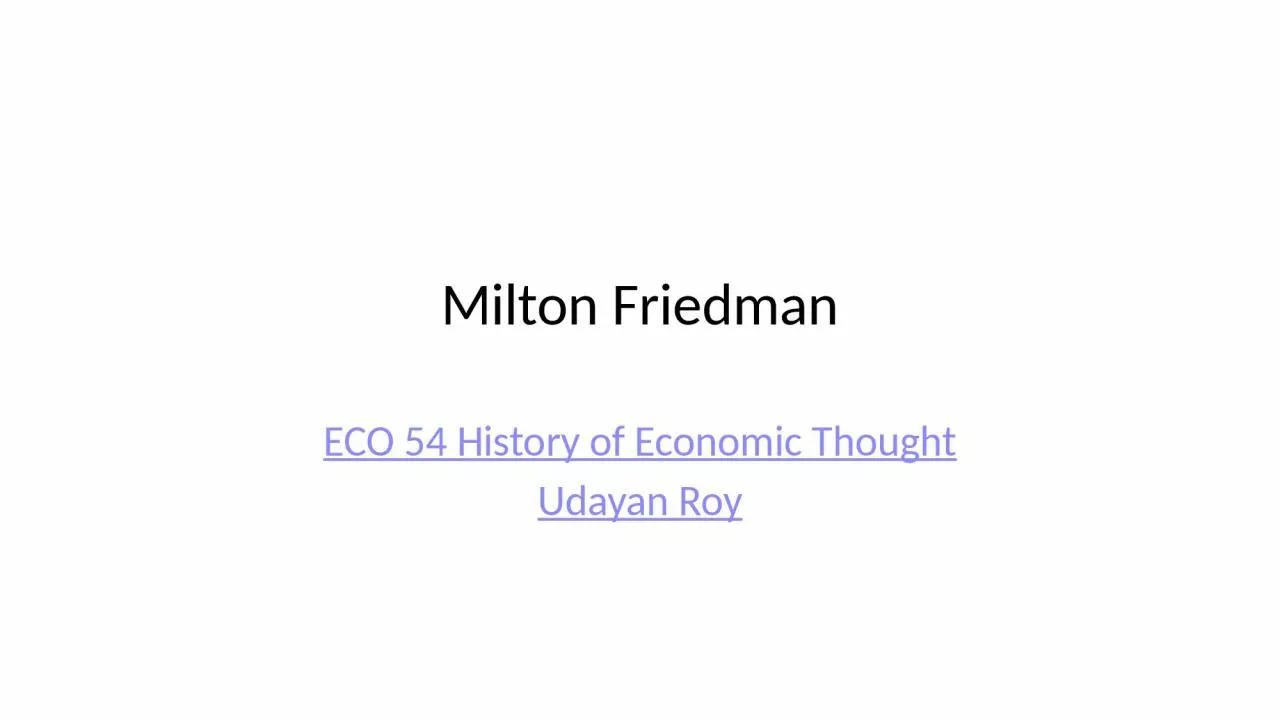

Udayan Roy Milton Friedman 19122006 A Monetary History of the United States 1963 with Anna J Schwartz A theory of the consumption function 1957 Selected Bibliography Milton Friedman ID: 1027704
Download Presentation The PPT/PDF document "Milton Friedman ECO 54 History of Econom..." is the property of its rightful owner. Permission is granted to download and print the materials on this web site for personal, non-commercial use only, and to display it on your personal computer provided you do not modify the materials and that you retain all copyright notices contained in the materials. By downloading content from our website, you accept the terms of this agreement.
1. Milton FriedmanECO 54 History of Economic ThoughtUdayan Roy
2. Milton Friedman (1912-2006)A Monetary History of the United States (1963), with Anna J. SchwartzA theory of the consumption function (1957)Selected BibliographyMilton Friedman2
3. Permanent Income Theory of ConsumptionFriedman argued that transitory changes in income do not affect consumption spending, only permanent changes doThis implies a small marginal propensity to consume and, therefore, a small multiplier. This makes Keynesian fiscal policy ineffective3Milton Friedman
4. Money affects outputFriedman argued that an increase in the money supply does have a positive effect on employment and production in the short runThis is because of “money illusion”. Friedman argued that the Great Depression was probably caused by a sharp reduction in money supply by the US central bank, the Fed.In the long run, however, the quantity of money affects the price level alone4Milton Friedman
5. Monetary policyDespite the effect of the money supply on output, there are lags that make monetary policy ineffective. Observation lagDecision lagEffect lagMilton Friedman5
6. Monetary policyTherefore, monetary policy should follow simple rules and not try to adjust to shifting economic situations. In particular, if an economy’s GDP normally grows at the rate of 3.5% per year, then its central bank should increase the quantity of money at the same rate every year. This will keep prices stable over the long run.Friedman consequently favored the abolition of the Federal ReserveMilton Friedman6
7. The Phillips CurveA. W. Phillips (1914 – 1975) looked at British data between 1861 and 1957 and found an inverse relationship between the rate of wage increase and the unemployment rate Paul Samuelson and Robert Solow argued in 1960 that the Phillips Curve was a guide to policy making: A country could keep unemployment low forever as long as it was willing to accept a stable—but high—rate of inflationFriedman pushed backMilton Friedman7
8. Natural rate of unemploymentIn the long run there is no tradeoff between inflation and unemployment.Sustained attempts by the government to keep unemployment below the natural rate will lead to accelerating inflationThe argument emphasizes the importance of inflation expectations8Milton Friedman
9. Flexible Exchange RatesFriedman was among those who first realized - and could explain - why the Bretton Woods System with relatively fixed rates of exchange was bound to break down sooner or later.9Milton Friedman
10. LibertarianismFriedman was a vigorous participant in public policy debatesHad a weekly column in Newsweek, recorded TV documentary series, wrote popular books on economic issuesLegalization of drugs and prostitutionVolunteer armySchool vouchersAbolition of licensing requirements of doctorsNegative income tax10Milton Friedman
11. Friedman v. KeynesThere are indications that Friedman was not as opposed to Keynesian stabilization policies as some may believePaul Krugman: Friedman … commended instead the then Chicago view that banks should be rescued, government should act to reflate the economy, and that there was a strong case “for the use of large and continuous deficit budgets to combat the mass unemployment and deflation of the times.”http://krugman.blogs.nytimes.com/2013/04/14/milton-friedman-currency-debaser/Milton Friedman11
12. Friedman v. KeynesSee also:http://delong.typepad.com/sdj/2013/04/its-the-seventieth-anniversary-of-abba-lerners-functional-finance.htmlhttp://www.forbes.com/sites/timothylee/2012/04/02/milton-friedman-inflation-dove/Milton Friedman12
13. Sourceshttp://myweb.liu.edu/~uroy/eco54/histlist/Friedman_M/index.htmChapter X of New Ideas from Dead Economists by Todd BuchholzChapter 13 of The Ordinary Business of Life by Roger Backhouse; pages 295-8 http://www.hetwebsite.net/het/profiles/friedman.htm13Milton Friedman
14. Sourceshttp://en.wikipedia.org/wiki/Milton_Friedmanhttp://www.nobelprize.org/nobel_prizes/economics/laureates/1976/Milton Friedman14
15. Milton Friedman15